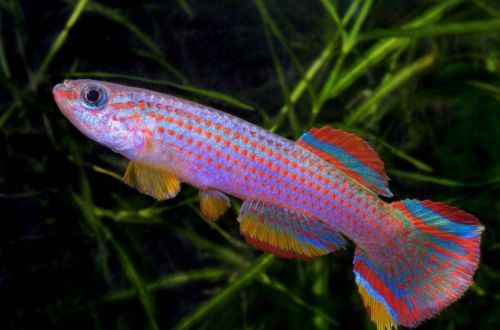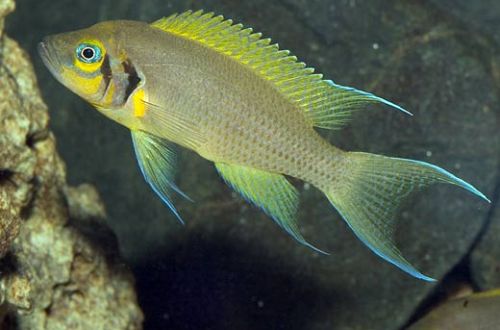
Aphiosemion striatum
Afiosemion striatum or Red-striped Killy fish, scientific name Aphyosemion striatum, belongs to the Nothobranchiidae family. A beautiful and miniature fish, distinguished by its unpretentiousness and peaceful disposition, therefore it is perfect for beginner aquarists. It is a relatively long-lived species, which is not typical for Killy fish.

Habitat
It originates from the swampy areas of the Mitémele river system, which flows in the equatorial part of Africa through the territory of modern Gabon and Equatorial Guinea. It lives in shallow pools, freshwater swamps, freshwater streams in the forest floor of the rainforest.
Description
Elongated slender body with graceful rounded fins and tail. The dorsal fin is strongly displaced towards the tail. The coloration is pink, in males four horizontal red stripes run all over the body. The fins also have a striped pattern with alternating blue and red colors. The pelvic fins are yellow. The coloration of females is noticeably more modest, monophonic with transparent fins, the scales have a dark edging.
Food
In the wild, they feed on various invertebrates; in a home aquarium, it is advisable to serve small live or frozen foods, such as daphnia, bloodworms. They can also eat dry food (granules, flakes), but this requires gradual accustoming. Feed 2-3 times a day in an amount that will be eaten within 5 minutes.
Maintenance and care
A couple of fish will feel comfortable in a small tank of 10 liters, but it is recommended to purchase a larger aquarium. In the design, try to reproduce the natural habitat. Dark sandy substrate with scattered pieces of bog wood, snags, tree branches for shelter. Dense thickets of plants, including floating, they create an additional shade.
Water conditions are typical for most swamps – water is soft (dH index) slightly acidic or neutral (pH index). The required parameters are achieved by simple boiling. For more information about pH and dH parameters and how to change them, see the “Hydrochemical composition of water” section.
Maintenance of the aquarium includes a weekly procedure for cleaning the soil and replacing part of the water (15-20%) with fresh water. Service intervals can be extended up to 2 weeks or more if a high performance filtration system is installed. In the budget version, a simple sponge filter will suffice. Other minimum equipment required includes a heater, an aerator, and a lighting system set to dim.
Behavior
Peaceful and shy appearance, more active neighbors can easily intimidate the modest Afiosemion. Joint keeping is possible with other peaceful species, such as some of the viviparous, small characins, Corydoras catfish, etc. No intraspecific conflicts have been noticed, they successfully live in pairs and large groups. The latter option is preferable, a flock of colorful fish looks much more interesting than single individuals.
Breeding
Reproduction of Afiosemion striatum is not an easy task, it spawns successfully in a home aquarium, however, the production of fry is not guaranteed. Successful spawning is possible in a separate tank when favorable conditions are created.
The spawning aquarium is selected small, 5 liters is enough, a sponge airlift filter is installed in it to prevent water stagnation, and a heater. Lighting is not needed, the eggs develop in the twilight. Coarse sand substrate with dense growths of low vegetation such as Java moss.
Spawning is stimulated by soft and slightly acidic water (6.0–6.5pH) and a varied diet of live or frozen foods. Since these conditions coincide with those recommended for keeping this species, it is better to determine the imminent mating season by external signs. The male becomes brighter, the female rounds off from the eggs.
If there are a lot of fish, choose the largest and brightest male with a female and place it in a spawning aquarium. The female lays about 30 eggs per day, the whole process can take up to a week. At the end, the parents return.
The incubation period lasts approximately 18 days, depending on the temperature. Eggs are sensitive to light, so keep the spawning tank in a semi-dark environment. The fry appear very small, the most successful solution would be feeding with ciliates, as Artemia nauplii mature.
Fish diseases
Suitable living conditions minimize the likelihood of a disease outbreak. The threat is the use of live food, which is often a carrier of parasites, but the immunity of healthy fish successfully resists them. Read more about symptoms and treatments in the Aquarium Fish Diseases section.





